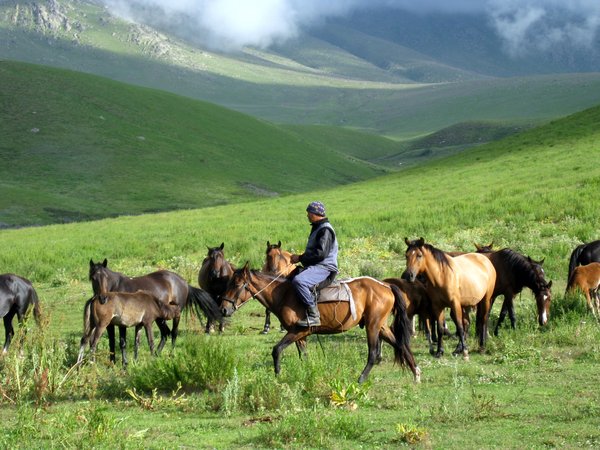Kyrgyzstan
7000m+ mountains; stunning alpine lakes; lush foothills covered in pine forests; yurt-dwelling horse breeders, yak herders and shepherds everywhere; constant invitations to drink fermented horse milk; and ulak, the craziest sport on the planet, no exaggeration. All of these contribute to making Kyrgyzstan an amazing places to travel in, which is why I included it on this site despite being more “off the beaten track” than “off the unbeaten track”.
The first things I should mention about travel in Kyrgyzstan are the following two organisations: Community-Based Tourism (CBT) and Shepherd’s Life. They are set up to help local people make a bit of money from tourism by providing homestays, yurt stays, guides and horse treks. Travellers’ reports on them are for the most part good, although it does seem they bring in tourist money only to one or two people in each village for the home stays rather than spreading money throughout the community and their yurt stays are in very unauthentic yurts especially designed for tourists. My advice is to use CBT or Shepherd’s Life representatives in towns or villages for information, which they are always happy to give for free without trying to sell their services, then do your trekking on your own. They can, for example, point you to the beginning of the trail from Kyzart over the mountains to Lake Song Kol, which is very easy to follow without a guide once you know where it starts. This way you will not have to pay a guide and you will undoubtedly be invited to stay in real yurts by real shepherds who you can then give US$5 – US$10 per night as a thank you present when you leave. This advice is valid for all the areas covered on this website, where trails are easy to follow once you have been pointed in the right direction. If, however, you plan to do any serious mountaineering or trekking in uninhabited areas you should of course take a guide unless you are a very experienced trekker. If you speak no Russian or Kyrgyz whatsoever you should probably bring a tent just in case, as invitations to stay with herders may be less forthcoming. Travelling like this I averaged US$10 a day over a month in 2010, got plenty of free horse rides to with locals I was staying with who invited me up into the mountains with them to their herds, saw a real 50-man game of ulak instead of the pathetic 5-man ones organised by CBT especially for tourists and only slept in a hotel a total of 5 nights over the whole month.
Unless you are crossing into Kyrgyzstan from China, Kazakhstan, Uzbekistan or Tajikistan, or taking a long-distance train from Russia, you are likely to begin your trip in Bishkek, Kyrgyzstan’s capital. Transport along the road heading south-east out of the city in the direction of Lake Song Kol goes from Bishkek’s Zapadny Avtovokzal (Western bus station). There are lots of shared taxis, some cheaper public minivans and perhaps one even cheaper bus every day to most major settlements. Transport south-west out of the city in the direction of Suusamyr, Osh, Sary Moghul and Tajikistan goes from Bishkek’s Osh Bazaar. There are connecting roads between the south-east and south-west roads further south in the country but no public transport on them, so you need to hitch hike or hire your own car, both of which are very easy. The more northerly of these two connecting roads passes through Kyzyl Oi.
If you don’t want the hassle of finding public transport or don’t like the idea of doing so without Russian language skills you can hire a guide, your own vehicle or horse at the CBT office in Bishkek (address: 58 Gorkiy on the corner with Matrossov).

Leave a Reply